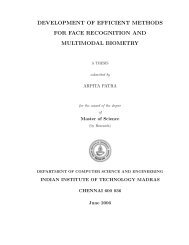The Enigma of Group Theory - Department of Computer Science ...
The Enigma of Group Theory - Department of Computer Science ...
The Enigma of Group Theory - Department of Computer Science ...
You also want an ePaper? Increase the reach of your titles
YUMPU automatically turns print PDFs into web optimized ePapers that Google loves.
http://www.cs.bris.ac.uk University <strong>of</strong> Bristol, <strong>Department</strong> <strong>of</strong> <strong>Computer</strong> <strong>Science</strong><br />
4 Determining the day settings<br />
Now having determined the internal wirings, given the set <strong>of</strong> two months <strong>of</strong> day settings obtained by<br />
Bertrand, the next task is to determine the actual key when the day settings are not available. At this<br />
stage we assume the Germans are still using the encrypt the message setting twice routine.<br />
<strong>The</strong> essential trick here is to notice that if we write the cipher as<br />
then<br />
ɛj = τ · γj · τ,<br />
ɛj · ɛj+3 = τ · γj · γj+3 · τ.<br />
So ɛj · ɛj+3 is conjugate to γj · γj+3 and so by Fact 1 they have the same cycle structure. More importantly<br />
the cycle structure does not depend on the plug board τ.<br />
Hence, if we can use the cycle structure to determine the rotor settings then we are only left with<br />
determining the plugboard settings. If we can determine the rotor settings then we know the values <strong>of</strong><br />
γj, for j = 1, . . . , 6, from the encrypted message keys we can compute ɛj for j = 1, . . . , 6 as in the previous<br />
section. Hence, determining the plugboard settings is then a question <strong>of</strong> solving one <strong>of</strong> our conjugacy<br />
problems again, for τ. But this is easier than before as we have that τ must be a product <strong>of</strong> disjoint<br />
transpositions.<br />
We have already discussed how to compute ɛj · ɛj+3 from the encryption <strong>of</strong> the message keys. Hence,<br />
we simply compute these values and compare their cycle structures with those obtained by running<br />
through all possible<br />
60 · 26 3 · 26 3 = 18, 534, 946, 560<br />
choices for the rotors, positions and ring settings. Note, that when this was done by the Poles in the<br />
1930’s there was only a choice <strong>of</strong> the ordering <strong>of</strong> three rotors. <strong>The</strong> extra choice <strong>of</strong> rotors did not come in<br />
till a bit later. Hence, the total choice was 10 times less than this figure.<br />
<strong>The</strong> above simplifies further if we assume that no stepping <strong>of</strong> the second and third rotor occurs during<br />
the calculation <strong>of</strong> the first six ciphertext characters. Recall this happens around 77 percent <strong>of</strong> the time.<br />
In such a situation the cycle structure depends only on the rotor order and the difference pi − ri between<br />
the starting rotor position and the ring setting. Hence, we might as well assume that r1 = r2 = r3 = 0<br />
when computing all <strong>of</strong> the cycle structures. So, for 77 percent <strong>of</strong> the days our search amongst the cycle<br />
structures is then only among<br />
60 · 26 3 = 1, 054, 560 (resp. 105, 456)<br />
possible cycle structures. Whilst this may seem a lot to do without a modern computer the Polish<br />
cryptographers found various ingenious ways <strong>of</strong> making this tractable.<br />
After the above procedure we have determined all values <strong>of</strong> the initial day setting bar pi and ri,<br />
however we know the differences pi − ri. We also know for any given message the message key p ′<br />
, p′ , p′<br />
1 2 3 .<br />
Hence, in breaking the actual message we only require the solution for r1, r2, the value for r3 is irrelevant<br />
as the third rotor never moves a fourth rotor. Most German messages started with the same two letter<br />
word followed by space (space was encoded by ’X’). Hence, we only need to go through 26 2 different<br />
positions to get the correct ring setting. Actually one goes through 26 2 wheel positions with a fixed ring,<br />
and use the differences to infer the actual ring settings. Once, ri is determined from one message the<br />
value <strong>of</strong> pi can be determined for the day key and then all messages can be trivially broken.<br />
Once the rotor positions had been found for the day, the next task was to compute the positions <strong>of</strong><br />
the plugs. However, once the rotors are determined the <strong>Enigma</strong> machine becomes very much like a<br />
substitution cipher. It is not quite a substitution cipher, however the same cryptanalytic techniques can<br />
be applied. That is one determines the plugboard settings from the viewing the enough ciphertext and<br />
from the statistics <strong>of</strong> the underlying language, which in this case is German.<br />
13










